Email Subject Lines: 10 Data-Backed Ways to Boost Open Rates (+Examples)
Jenny Keohane
Contents
- 1. Use Numbers in Your Email Subject Lines
- 2. Keep Your Subject Line Between 1-5 Words (+ Remember Mobile Devices)
- 3. Appeal to Emotion: Curiosity, Empathy, FOMO
- 4. Ask Questions
- 5. Use Language That Shows Immediacy
- 6. Avoid Words & Punctuation Marks That Trigger Spam Filters
- 7. Personalize, Personalize, Personalize
- 8. Indicate a Forward or Reply in Your Subject Line
- 9. Give Relevant Resources and Provide Value
- 10. Avoid Using Phrases That Decrease Opens & Replies
Cold emails can be the fastest way to win new business, and the fastest way to lose it, it all starts with your email subject line.
Your subject line’s effectiveness comes down to a lot of factors for such a small word count.
There’s no “golden principle” to creating the perfect subject line, but there is data to guide you in the right direction.
Based on various Yesware studies that have analyzed millions of emails, we combined our top 10 email subject line findings. Whether you use these findings for email marketing or sales outreach, they’ll undoubtedly get recipients to click.
These findings will help both marketers and sales professionals get their open rates up. Let’s dive in.
1. Use Numbers in Your Email Subject Lines
Yesware analyzed 115 million emails sent and found clear evidence that email subject lines that include numbers have higher than average open and reply rates.
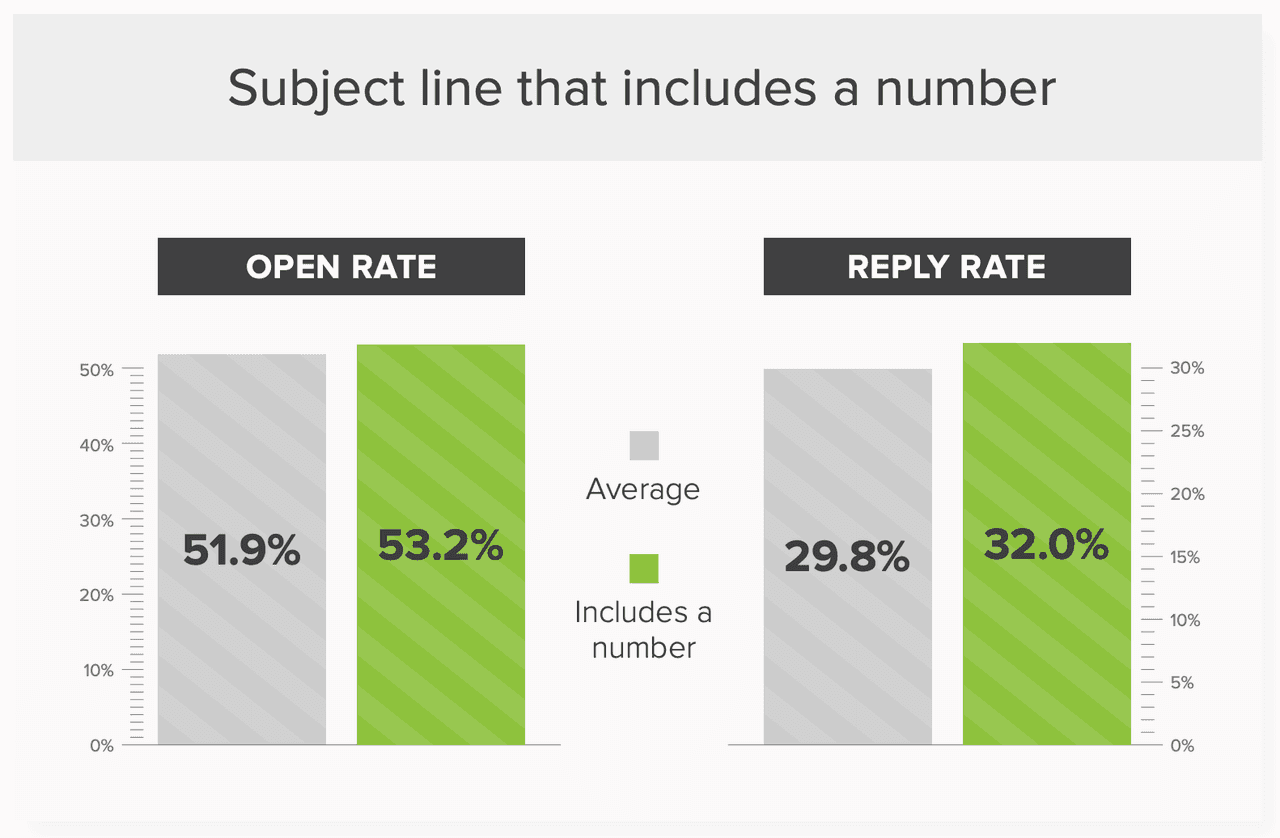
For cross-validation, we also conducted a 2021 cold email subject line study that analyzed 1.2 million emails. The study found that subject lines that include numbers get a 45% higher open rate than the average open rate.
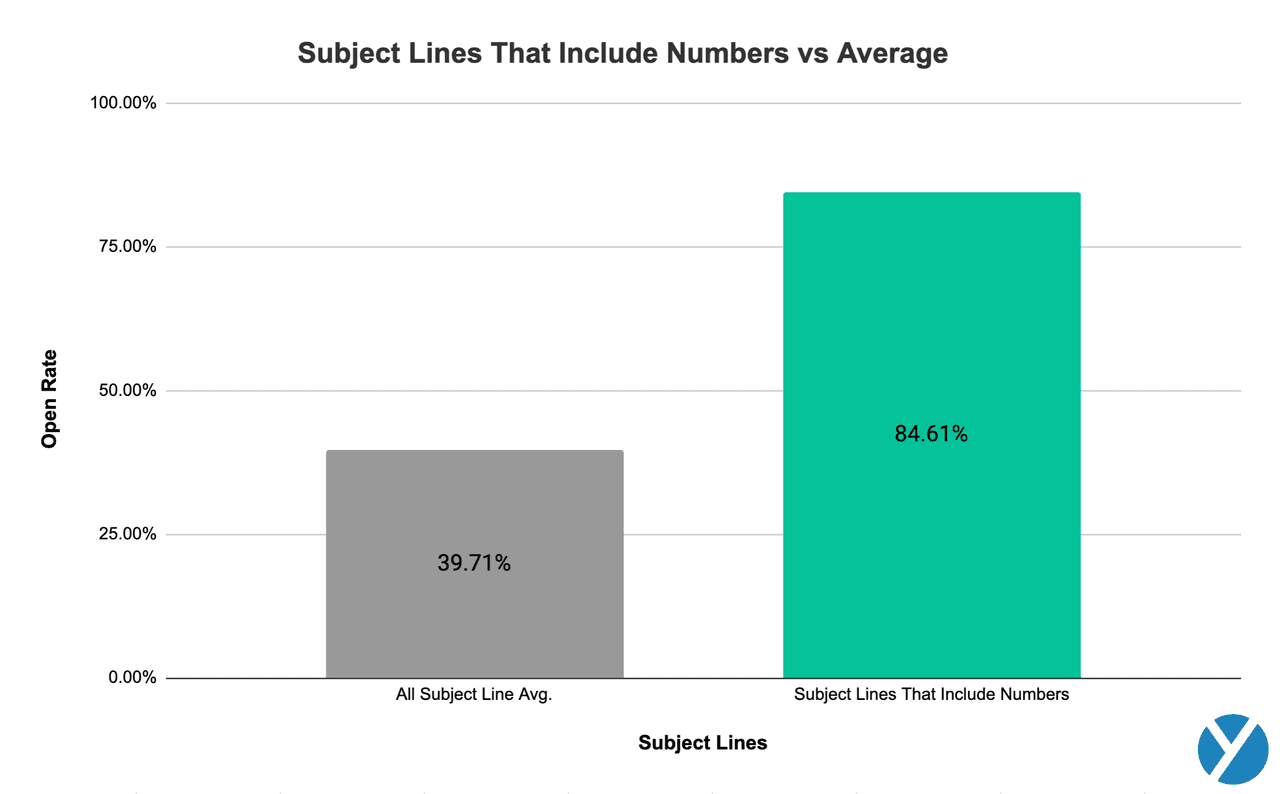
Why? Numbers stand out. They communicate something that words may not be able to.
Hard numbers > general descriptions when it comes to a prospecting email – the first builds credibility, the second damages it.
Using a number in your email subject line is your power of persuasion.
Tip: If you typically mention a case study in your prospecting email, take the metric of success that your customer achieved, and put that in your subject line. Ex: “175 Hrs/Month Back”
2. Keep Your Subject Line Between 1-5 Words (+ Remember Mobile Devices)
In a recent email template study, we analyzed 262,518 email templates and found that with subject lines, open rates peak between 1-5 words.
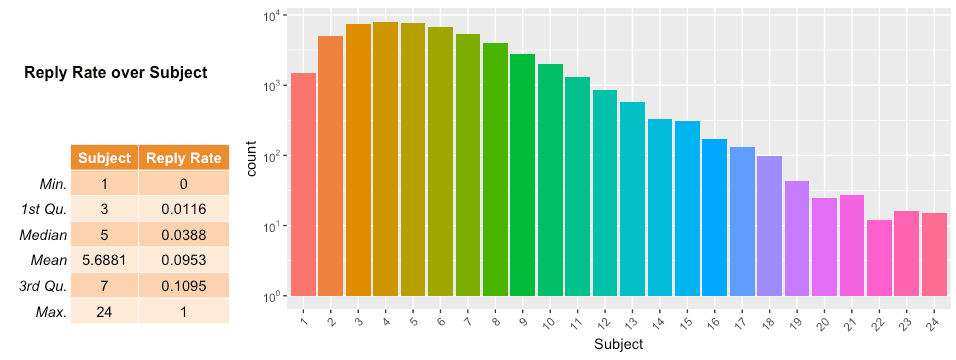
The most successful emails based on open and reply rates had subject lines between 1-5 words.
Your email subject line should give the recipient an indication of what your email is about while remaining clear and concise. If your subject line needs to be longer, make sure you put the important or compelling information at the beginning.
Also, remember mobile devices.
The majority of email research concludes that mobile is responsible for at least 50% of all opens. That being said, it’s important to keep mobile users in mind and limit your subject line to fewer than 50 characters or under 7 words to ensure recipients will see the full subject line in their inbox.
3. Appeal to Emotion: Curiosity, Empathy, FOMO
One of the best ways to increase your email open rates is to write subject lines that appeal to emotions and connect with recipients.

When we relate to something, it activates a part of the brain called the insula (our emotional powerhouse). And we all know emotion drives us to react (read: open).
Addressing pain points is key. Your job is to address their pain point in the subject line to get an open, and then solve it for them in the body of your email. This will be what drives the reply.
Also, FOMO (fear of missing out) has long been a powerful psychological principle. And studies show that 56% of people experience it.

Let’s look at some examples.
I combed through my inbox to find some examples of FOMO, these email subject lines got me to click instantly.
Great Email Subject Lines Using FOMO:
- Neil Patel: I wish I knew this before I started doing SEO
- G2: We should’ve told you sooner
- Mixpanel: See how one company increased conversions by 20%
- JetBlue: You’re missing out on points
- Canva: Don’t miss the opportunity to level up your Zoom Background
4. Ask Questions
Questions pique curiosity. As humans, when presented with a question we develop an urge to know the answer. When used in subject lines, this promotes recipients to open the email to find that answer.
In our cold email subject line study, we found that subject lines that are questions get higher than average open rates — about 10% more.
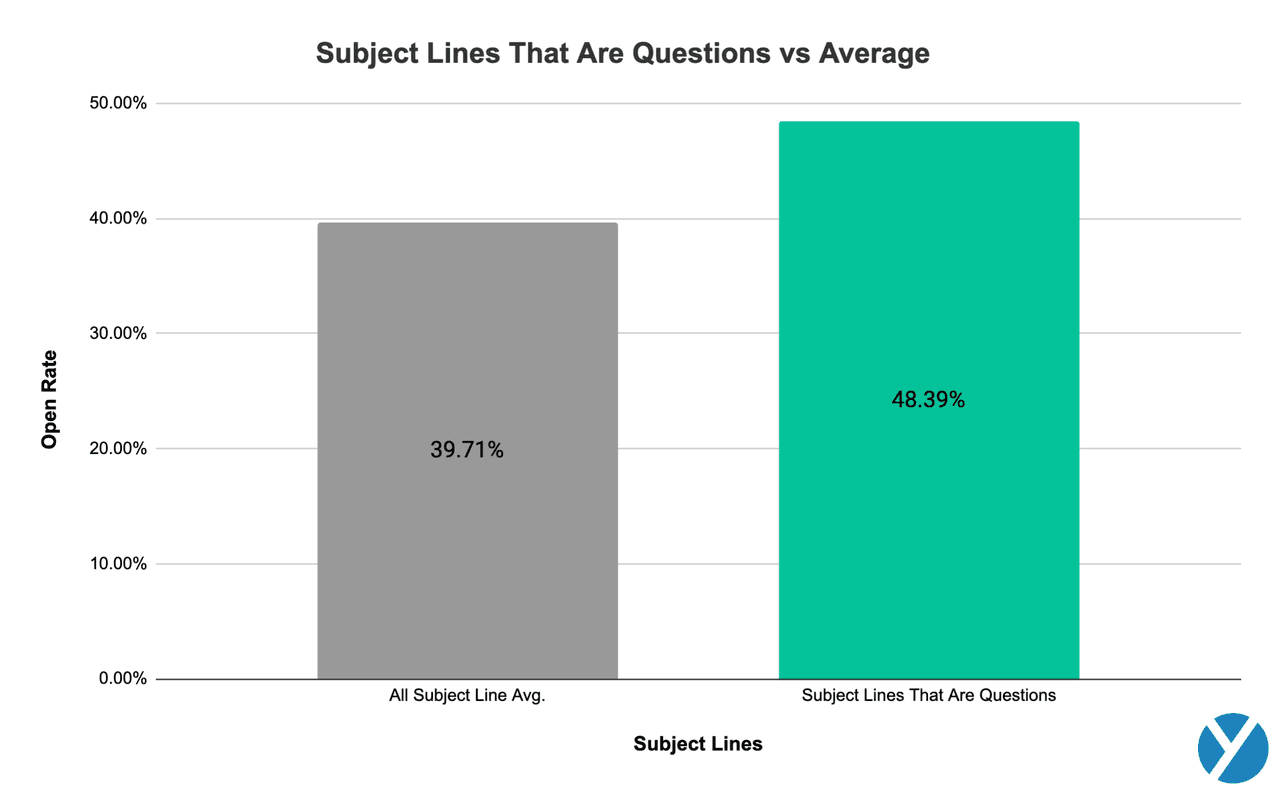
Best Email Subject Lines That Are Questions:
In our study, we found that these subject lines that are questions generated over 85% open rates.
- “What more could you want?”
- “Why [Company]? And why now?”
- “Are you ready?”
- “[Name], is there too much on your plate?”
- “What would you do with [Number] more hours per week?”
5. Use Language That Shows Immediacy
Research reveals that sending recap emails later in the week decreases reply rates.
Email subject lines that imply same-day send times as meetings receive more opens and replies than reminders sent days before and meeting follow-ups sent days after.
Here’s the data, broken down by open rates and reply rates, compared to the average:
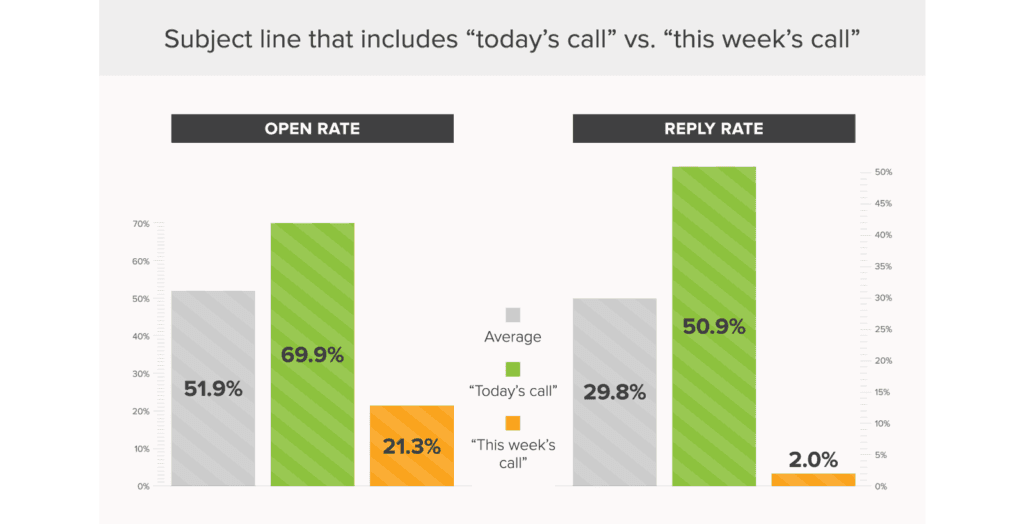
This is an important finding to boost your open rates and communicate important information.
Also, when it comes to communicating a sense of urgency – don’t use words like “act now” or “now only” – these sounds very spam-like. Let’s review that next.
6. Avoid Words & Punctuation Marks That Trigger Spam Filters
There’s nothing worse than your email going right into the black hole of a spam folder – with no opportunity for your recipient to open it. The truth is, the overuse of email and high-velocity sales tactics has required spam filters to be more unforgiving than ever.
And the harsh reality is that alone your email subject line could cause your entire email to go off to spam.
Here are the top two subject line behaviors you should avoid to ensure your email doesn’t get flagged as spam:
1.) AVOID ALL CAPS! Nobody likes to be yelled at. Avoid all caps in both the body of your email and your subject line. Email filters catch these easily.
2.) Avoid using multiple exclamation points!!! This looks very spam-like and just plain right unprofessional – try to avoid this.

These are the two most common patterns in spam folders. As seen above, these were found in the dark hole of my very own spam folder.
Also, the specific words you choose in your email subject line might be preventing you from reaching your prospect in the first place. Spam filters pick up on common spam-like words. Including these trigger words will increase your chances of getting flagged.
After extensive research, here are some of our top spam trigger words we advise you to avoid using:

7. Personalize, Personalize, Personalize
Countless studies show the power of personalization in your email subject lines.
Even adding the recipient’s name can make a difference – studies show that these are 26% more likely to be opened.

No two recipients are the same – make it known that you’re writing this message for them rather than your entire email list. They’ll be much more inclined to open.
At this point in time, personalizing emails should be easy. You have the information and tools you need to do so.
So, always make sure your message is catered to the recipient – whether that’s their name, location, or occupation. It not only helps build rapport but will increase the likelihood of your email getting opened in the first place.
In fact, a SaleCycle study shows the average open rates grouped by subject line content.
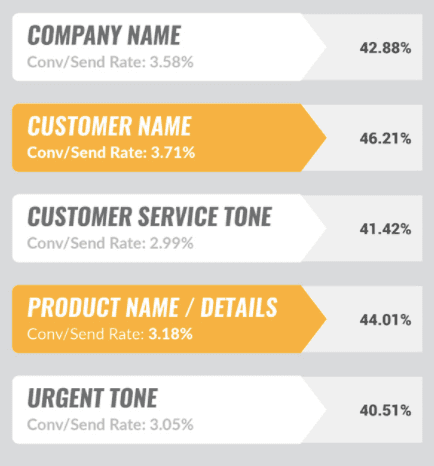
Try it out, use these personalization factors and see what resonates best.
This is key to building rapport with your recipients right off the bat.
8. Indicate a Forward or Reply in Your Subject Line
Based on Yesware’s research, it looks like recipients are more likely to open an email with an “Fwd:” and “Re:” in your email subject line.
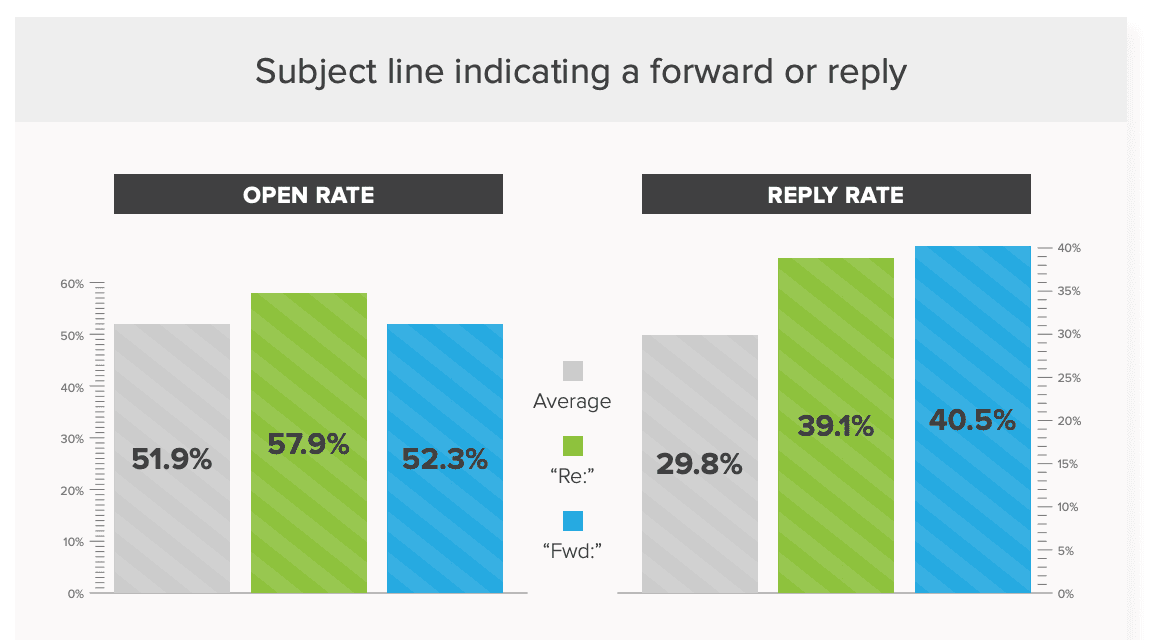
This hints to the email recipient that they have had a prior conversation with the sender.
So, that being said, if you’re following up a prior email that you’ve sent to a prospect, reply as a thread. Your recipient will then see that you’ve sent an email prior.
This not only helps increase the likelihood of your recipients opening the email, but also provides them with more information by viewing previous messages – it’s a win-win.
Tip: To save time, use tools like Campaigns to automate an entire drip campaign to a prospect and ensure your email is sent as a thread with the message history included.
9. Give Relevant Resources and Provide Value
You need to give in order to get.
It’s all about the power of reciprocity. We feel obligated to repay to others what they provide to us.
In psychology, reciprocity is a universally accepted social rule – reciprocity is ‘the practice of exchanging things for mutual benefit’. This social norm is instinctively engraved in us. And this can actually play a huge role in your sales/marketing outreach.
This means when you give someone a resource that helps them in their day-to-day job, they become more likely to agree to the conversation you’re starting.
It’s the same reason we say thank you when someone holds the door.
Let’s look at some email subject line examples, taken from both email marketing campaigns and sales emails.
Good Email Subject Line Examples That Provide Value:
- SurveyMonkey: New data shows how marketers can build trust
- TechTarget: Why BANT is broken for B2B demand gen
- Yesware: 10 cold email formulas that just plain work
- Wistia: Creative ways to forge ahead with remote work
- Airbnb: 6 designer tips to refresh your home
- Trello: Lead remote teams with this step-by-step guide
10. Avoid Using Phrases That Decrease Opens & Replies
People are tired of seeing the same phrases in their inbox. If your email looks like every other email, they’ll likely scroll right by you.
In an email study we conducted, we found common phrases in subject lines that led to fewer open and replies than average.
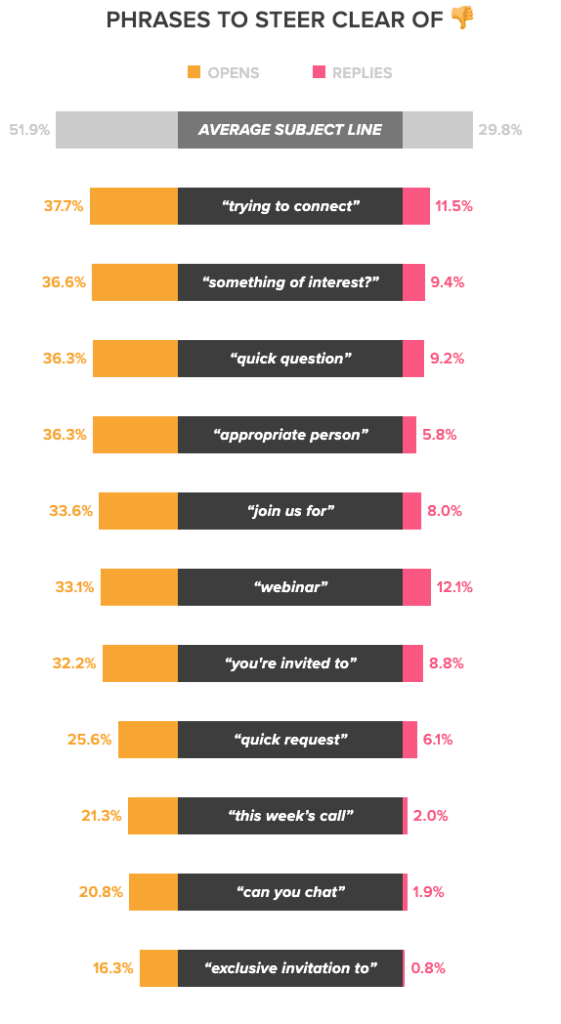
A/B Test Your Email Subject Lines to Boost Open Rates
Although data and studies can help steer you in the right direction, the best way to figure out what works best for you and your audience is a/b testing subject lines for yourself. Try out new strategies and tactics, then measure the results.
Some professionals use emojis to stand out, some use FOMO, some cut straight to the chase.
Whether you’re sending your emails to leads, subscribers, prospects, etc. — remember that all audiences are different.
Try out different email subject lines, A/B test, and make data-driven changes.
Get sales tips and strategies delivered straight to your inbox.
Yesware will help you generate more sales right from your inbox. Try our Outlook add-on or Gmail Chrome extension for free, forever!
Related Articles
Jenny Keohane
Jenny Keohane
Melissa Williams
Sales, deal management, and communication tips for your inbox

